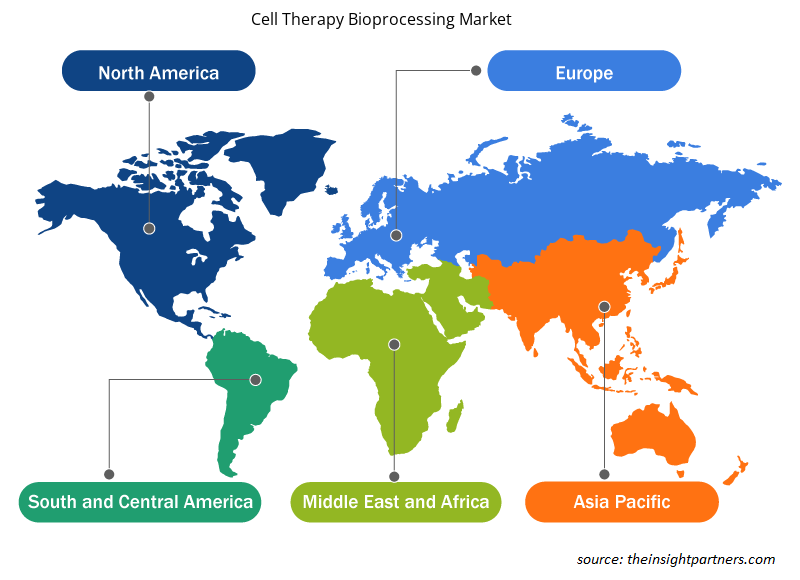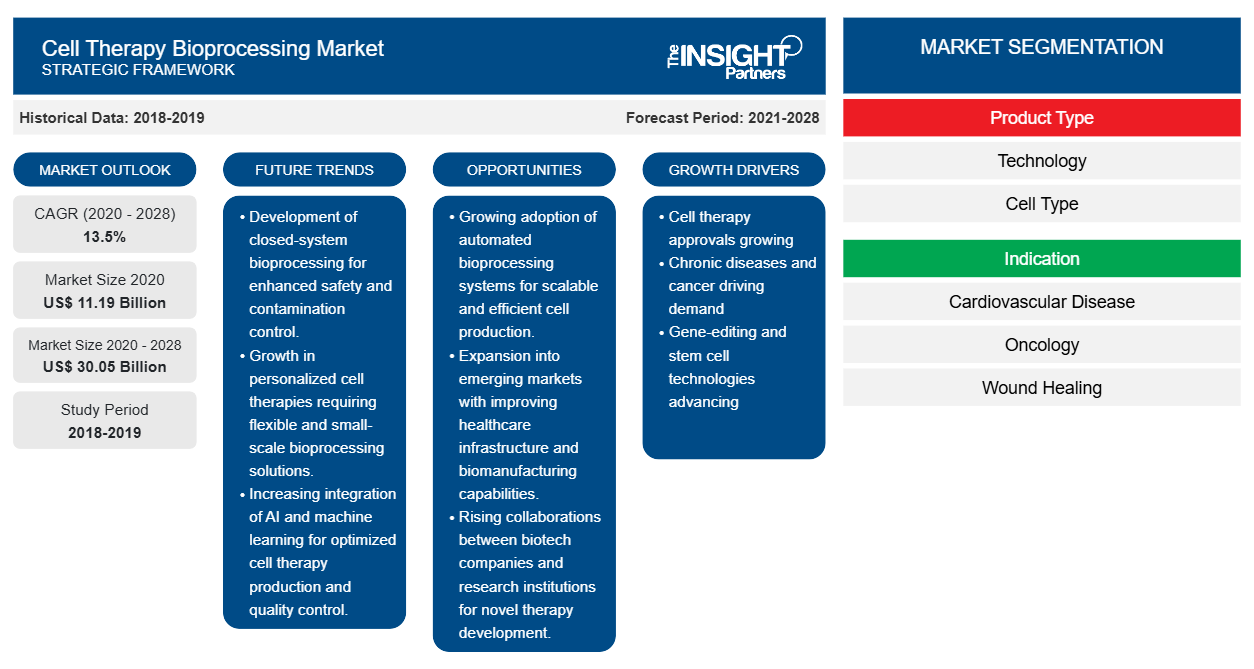Die Zelltherapie-Bioverarbeitung dürfte von 11.192,50 Millionen US-Dollar im Jahr 2020 auf 30.052,61 Millionen US-Dollar im Jahr 2028 anwachsen. Der Markt dürfte zwischen 2021 und 2028 mit einer durchschnittlichen jährlichen Wachstumsrate von 13,5 % wachsen.
Der Markt für Zelltherapie-Bioverarbeitung wurde auf der Grundlage von Technologie, Zelltyp, Endnutzer und Region analysiert. Der Markt ist nach Regionen segmentiert in Nordamerika, Europa, Asien-Pazifik, den Nahen Osten und Afrika sowie Süd- und Mittelamerika. Der Bericht betont Parameter wie Markttrends, technologische Fortschritte, Marktdynamik und die Analyse der Wettbewerbslandschaft führender Unternehmen, um Einblicke und eingehende Analysen des Marktes für Zelltherapie-Bioverarbeitung zu bieten . Er umfasst auch die Analyse der COVID-19-Pandemie auf dem gesamten Markt in allen wichtigen Regionen.
Passen Sie diesen Bericht Ihren Anforderungen an
Sie erhalten kostenlose Anpassungen an jedem Bericht, einschließlich Teilen dieses Berichts oder einer Analyse auf Länderebene, eines Excel-Datenpakets sowie tolle Angebote und Rabatte für Start-ups und Universitäten.
- Holen Sie sich die wichtigsten Markttrends aus diesem Bericht.Dieses KOSTENLOSE Beispiel umfasst eine Datenanalyse von Markttrends bis hin zu Schätzungen und Prognosen.
Markteinblicke
Immer mehr Zulassungen für Zelltherapien
Zelltherapien haben positive Ergebnisse bei der Behandlung verschiedener chronischer Krankheiten, darunter seltener genetischer Störungen, gezeigt, indem sie regenerative Medikamente und personalisierte Medikamente anbieten. Der zunehmende Bedarf an Behandlungen für chronische Krankheiten hat die Forschungs- und Entwicklungsaktivitäten vorangetrieben, was zu einer wachsenden Produktion von Zelltherapien und Produktzulassungen geführt hat. Nachfolgend sind einige Beispiele für die Zulassungen von Zelltherapien aufgeführt, die zum Wachstum des Marktes für Zelltherapie-Bioverarbeitung beigetragen haben.
- Im Mai 2019 genehmigte die Food and Drug Administration (FDA) Zolgensma, hergestellt von AveXis, Inc., einer Tochtergesellschaft der Novartis AG. Zolgensa ist zur Behandlung der spinalen Muskelatrophie bei Kindern unter zwei Jahren bestimmt und wird durch einmalige Infusion in die Vene verabreicht.
- Im Juli 2020 erhielt Kite Pharma, Inc., eine Tochtergesellschaft der Gilead Company, die FDA-Zulassung für Tecartus. Tecartus ist eine (CAR) T-Zelltherapie zur Behandlung von refraktärem Mantelzelllymphom (MCL) bei Erwachsenen. Laut der Gilead Company ist Tecartus die erste zugelassene (CAR) T-Zelltherapie für Mantelzelllymphom, die voraussichtlich einen neuen Meilenstein in der Behandlung von Mantelzelllymphom darstellen wird.
- Im Februar 2021 erhielt Juno Therapeutics, Inc., eine Tochtergesellschaft der Bristol-Myers Squibb Company, die Zulassung für sein Breyanzi. Breyanzi ist eine zellbasierte Gentherapie zur Behandlung bestimmter Arten von großzelligem B-Zell-Lymphom bei Erwachsenen. Die Behandlung wird verabreicht, nachdem der Patient auf mindestens zwei andere Arten systemischer Behandlungen nicht reagiert hat. Breyanzi hatte jedoch seit seiner ersten Einreichung im Jahr 2019 mit regulatorischen Rückschlägen zu kämpfen; es wird derzeit von der Europäischen Arzneimittel-Agentur geprüft und im Juli 2020 validiert.
So haben wachsende Produktentwicklungen zu verschiedenen Produktzulassungen geführt, die den Anstieg der Zelltherapien widerspiegeln. Daher wird erwartet, dass die zunehmenden Zulassungen für Zelltherapien die Bioverarbeitung von Zelltherapien enorm steigern, was wiederum das Marktwachstum in den kommenden Jahren vorantreiben dürfte.
Technologiebasierte Erkenntnisse
Der Markt für Zelltherapie-Bioverarbeitung ist nach Technologie in Bioreaktoren, Gefriertrocknung, Elektrospinning, Kontrollflusszentrifugation, Ultraschalllyse, Genomeditierungstechnologie, Zellimmortalisierungstechnologie und virale Vektortechnologie unterteilt. Das Bioreaktorsegment hielt im Jahr 2020 den größten Marktanteil, während das Genomeditierungstechnologiesegment im Prognosezeitraum voraussichtlich die höchste durchschnittliche jährliche Wachstumsrate von 14,5 % auf dem Markt verzeichnen wird.
Zelltypbasierte Erkenntnisse
Der Markt für Zelltherapie-Bioverarbeitung ist nach Zelltyp in Stammzellen, Immunzellen, menschliche embryonale Stammzellen, pluripotente Stammzellen und hämatopoetische Stammzellen unterteilt. Das Stammzellensegment hatte im Jahr 2020 den größten Marktanteil, während für dasselbe Segment im Prognosezeitraum die höchste durchschnittliche jährliche Wachstumsrate von 14,0 % auf dem Markt erwartet wird.
Endbenutzerbasierte Erkenntnisse
Der Markt für Zelltherapie-Bioverarbeitung ist nach Indikation segmentiert in Herz-Kreislauf-Erkrankungen (CVD), Onkologie, Wundheilung, Orthopädie und andere. Das Onkologie-Segment hatte 2020 den größten Marktanteil, und das Orthopädie-Segment dürfte im Prognosezeitraum mit 14,3 % die höchste durchschnittliche jährliche Wachstumsrate (CAGR) auf dem Markt verzeichnen.
Auf dem Markt für Zelltherapie-Bioverarbeitung tätige Unternehmen verfolgen organische Strategien wie Produkteinführungen und -erweiterungen, um ihre Präsenz und ihr Produktportfolio weltweit zu vergrößern und der wachsenden Nachfrage gerecht zu werden.
Regionale Einblicke in den Markt für Zelltherapie-Bioverarbeitung
Die regionalen Trends und Faktoren, die den Markt für Zelltherapie-Bioverarbeitung im Prognosezeitraum beeinflussen, wurden von den Analysten von Insight Partners ausführlich erläutert. In diesem Abschnitt werden auch die Marktsegmente und die Geografie für Zelltherapie-Bioverarbeitung in Nordamerika, Europa, im asiatisch-pazifischen Raum, im Nahen Osten und Afrika sowie in Süd- und Mittelamerika erörtert.

- Erhalten Sie regionale Daten zum Markt für Zelltherapie-Bioverarbeitung
Umfang des Marktberichts zur Zelltherapie-Bioverarbeitung
| Berichtsattribut | Details |
|---|---|
| Marktgröße im Jahr 2020 | 11,19 Milliarden US-Dollar |
| Marktgröße bis 2028 | 30,05 Milliarden US-Dollar |
| Globale CAGR (2020 - 2028) | 13,5 % |
| Historische Daten | 2018-2019 |
| Prognosezeitraum | 2021-2028 |
| Abgedeckte Segmente | Nach Produkttyp
|
| Abgedeckte Regionen und Länder | Nordamerika
|
| Marktführer und wichtige Unternehmensprofile |
|
Dichte der Marktteilnehmer im Bereich Zelltherapie-Bioverarbeitung: Auswirkungen auf die Geschäftsdynamik verstehen
Der Markt für Zelltherapie-Bioverarbeitung wächst rasant, angetrieben durch die steigende Endverbrauchernachfrage aufgrund von Faktoren wie sich entwickelnden Verbraucherpräferenzen, technologischen Fortschritten und einem größeren Bewusstsein für die Vorteile des Produkts. Mit steigender Nachfrage erweitern Unternehmen ihr Angebot, entwickeln Innovationen, um die Bedürfnisse der Verbraucher zu erfüllen, und nutzen neue Trends, was das Marktwachstum weiter ankurbelt.
Die Marktteilnehmerdichte bezieht sich auf die Verteilung der Firmen oder Unternehmen, die in einem bestimmten Markt oder einer bestimmten Branche tätig sind. Sie gibt an, wie viele Wettbewerber (Marktteilnehmer) in einem bestimmten Marktraum im Verhältnis zu seiner Größe oder seinem gesamten Marktwert präsent sind.
Die wichtigsten auf dem Markt für Zelltherapie-Bioverarbeitung tätigen Unternehmen sind:
- Fresenius Kabi AG
- Asahi Kasei Corporation
- Sartorius AG
- MERCK KGaA
- THERMO FISHER SCIENTIFIC INC.
Haftungsausschluss : Die oben aufgeführten Unternehmen sind nicht in einer bestimmten Reihenfolge aufgeführt.

- Überblick über die wichtigsten Akteure auf dem Markt für Zelltherapie-Bioverarbeitung
Nach Technologie
- Bioreaktor
- Gefriertrocknung
- Elektrospinnen
- Kontrollflusszentrifugation
- Ultraschalllyse
- Technologie zur Genomeditierung
- Zellimmortalisierungstechnologie
- Virale Vektortechnologie
Nach Zelltyp
- Stammzelle
- Immunzelle
- Menschliche embryonale Stammzelle
- Pluripotente Stammzellen
- Hämatopoetische Stammzelle
Nach Indikation
- Herz-Kreislauf-Erkrankungen (CVD)
- Onkologie
- Wundheilung
- Orthopädie
- Sonstiges
Nach Endbenutzer
- Krankenhäuser und Kliniken
- Diagnostikzentren
- Zentren für Regenerative Medizin
- Akademisches und Forschungsinstitut
Nach Geografie
Nordamerika
- UNS
- Kanada
- Mexiko
Europa
- Frankreich
- Deutschland
- Italien
- Vereinigtes Königreich
- Spanien
- Restliches Europa
Asien-Pazifik (APAC)
- China
- Indien
- Südkorea
- Japan
- Australien
- Restlicher Asien-Pazifik-Raum
Naher Osten und Afrika (MEA)
- Südafrika
- Saudi-Arabien
- Vereinigte Arabische Emirate
- Rest von MEA
Süd- und Mittelamerika (SCAM)
- Brasilien
- Argentinien
- Rest von SCAM
Firmenprofile
- Fresenius Kabi AG
- Asahi Kasei Corporation
- Sartorius AG
- MERCK KGaA
- THERMO FISHER SCIENTIFIC INC.
- Corning Incorporated
- Cytiva
- Lonza
- Repligen
- Catalent Inc
- Historische Analyse (2 Jahre), Basisjahr, Prognose (7 Jahre) mit CAGR
- PEST- und SWOT-Analyse
- Marktgröße Wert/Volumen – Global, Regional, Land
- Branchen- und Wettbewerbslandschaft
- Excel-Datensatz
Aktuelle Berichte
Verwandte Berichte
Erfahrungsberichte
Grund zum Kauf
- Fundierte Entscheidungsfindung
- Marktdynamik verstehen
- Wettbewerbsanalyse
- Kundeneinblicke
- Marktprognosen
- Risikominimierung
- Strategische Planung
- Investitionsbegründung
- Identifizierung neuer Märkte
- Verbesserung von Marketingstrategien
- Steigerung der Betriebseffizienz
- Anpassung an regulatorische Trends





















 Kostenlose Probe anfordern für - Markt für Zelltherapie-Bioverarbeitung
Kostenlose Probe anfordern für - Markt für Zelltherapie-Bioverarbeitung